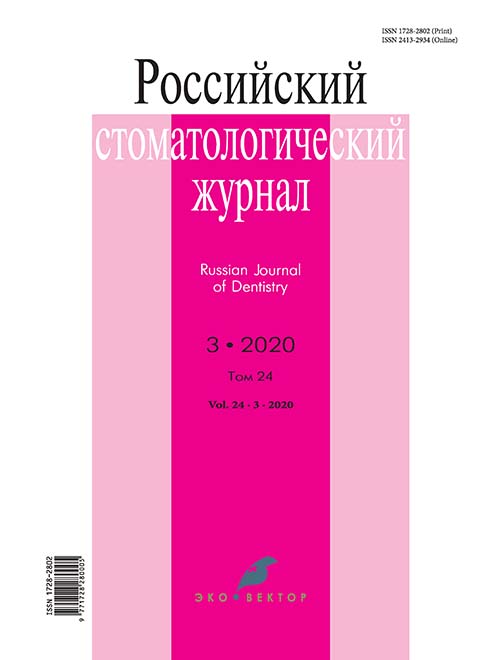An experimental study using known variants of transport immobilization and comparing them with the original temporary splint for the treatment of jaw fractures
- 作者: Mitin N.E.1, Zolotova M.I.1, Mitina E.N.1
-
隶属关系:
- Academician I.P. Pavlov Ryazan state medical University of the Ministry of health of the Russian Federation
- 期: 卷 24, 编号 3 (2020)
- 页面: 122-126
- 栏目: Experimental and Theoretical Investigations
- ##submission.dateSubmitted##: 02.10.2020
- ##submission.dateAccepted##: 02.10.2020
- ##submission.datePublished##: 15.06.2020
- URL: https://rjdentistry.com/1728-2802/article/view/46369
- DOI: https://doi.org/10.17816/1728-2802-2020-24-3-122-126
- ID: 46369
如何引用文章
详细
Academician I.P. Pavlov Ryazan state medical University of the Ministry of health of the Russian Federation, 390026, Ryazan, Russian Federation
Patients with injuries of the maxillofacial region make up about 30% of all patients treated in the in-patient departments of maxillofacial surgery. Meanwhile, fractures of the lower jaw account for about 70%—85% of all fractures of the bones of the face. The need for immobilization is due to the risk of pain and complications (bleeding, microbial contamination, asphyxiation, damage to nerves and blood vessels). The article provides a comparative analysis between temporary immobilization of the jaws using well-known designs and a new universal temporary bus with a channel. We conducted the experiment under simulated conditions using the following splinting structures: a smooth splint bar and a patented temporary splint with a channel for treating jaw fractures (Application No. 2020103350/14 (005106) (22) Application submission date 27.01.2020). From the experimental research complex, it was possible to verify that the methods of temporary splinting of the jaws have their own characteristics of superposition and displacement of structures. It is worth noting that the displacement of jaw fragments occurred in each splinting and this should definitely be taken into account at the stage of first aid. The study also revealed that that the splinting technique for the splint has a number of disadvantages, the most significant of which are the negative impact on periodontal disease, a significant decrease in oral hygiene, and the possibility of secondary infection. Among the obvious advantages of a universal temporary bus with a channel, include the simplicity of applying and fixing fragments, the ability to supply the patient, receive fluids and drugs through the probe, as well as ensuring full breathing in the absence of nasal breathing.
全文:
作者简介
N. Mitin
Academician I.P. Pavlov Ryazan state medical University of the Ministry of health of the Russian Federation
Email: sanferova94@mail.ru
俄罗斯联邦, Ryazan
Maria Zolotova
Academician I.P. Pavlov Ryazan state medical University of the Ministry of health of the Russian Federation
编辑信件的主要联系方式.
Email: sanferova94@mail.ru
full-time graduate student of the Department of Orthopedic Dentistry and Orthodontics with a course of propaedeutics of dental diseases Ryazan State Medical University of the Ministry of Health of Russia
俄罗斯联邦, RyazanE. Mitina
Academician I.P. Pavlov Ryazan state medical University of the Ministry of health of the Russian Federation
Email: sanferova94@mail.ru
俄罗斯联邦, Ryazan
参考
- Urgunaliev BK, Kulnazarov AS. The current state of the problems of traumatology of the maxillofacial area (review). Vestnik KGMA im. I.K. Akhun-baeva. 2016;(3):60–3. (in Russian)
- Pospelov NN, Luk'yanenko AV, Bazhenov OV, Sadovskiy IM. Features of the organization of medical care for the wounded in the face in modern local military conflicts. Meditsinskiy vestnik MVD. 2017;(6):27–31. (in Russian)
- Mitin NE, Rodina TS, Strelkov NN, Zolotova MI, Volkova VV. Variants of temporary mmobilization in jaw fractures. Rossiyskiy mediko-biologicheskiy vestnik imeni akademika I.P. Pavlova. 2018;26(4):559–66. (in Russian) doi: 10.23888/PAVLOVJ2018264559-566.
- Kopetsky IS, Nasibullin AM, Kabisova GS, Goncharova AV. Maxillofacial gunshot wounds in the context of a megalopolis. Meditsinskiy vestnik MVD. 2011;(6):19–23. (in Russian)
- Fleysher GM. Features of the clinical picture of mandibular fractures. Simvol nauki. 2016;(2–3):178–82. (in Russian)
- Sevbitov AV, Admakin OI, Vasil'ev YuL, Skatova EA, Mitin NE. Discussion: the features of using of the 1-st and 2-nd level reality simulators in the dentistry students training. Nauka molodykh (Eruditio Juvenium). 2015;(4):139–43. (in Russian)
- Sevbitov AV, Skatova EA, Dorofeev AE, Kuznetsova MYu. Eva-luation of pain perception during postoperative period in patients received dental surgical treatment. Dental Forum. 2014;(1):37–9. (in Russian)
- Lebedenko IYu, Kalivradzhiyan ES. Orthopedic dentistry. [Ortopedicheskaya stomatologiya]. Moscow: GEOTAR-Media; 2011. (in Russian)
- Sevbitov AV, Admakin OI, Vasilyev YuL, Skatova EA, Mitin NE, Grishin MI. Integration simulator 5 levels of realism in the educational process at the faculty. Nauka molodykh (Eruditio Juvenium). 2016;2:109–13. (in Russian)
- Mitin NE, Vasilyeva TA, Vasilyev EV. The chewing efficiency determining method based on application of original computer program using multi-variate data analysis. Rossiyskiy mediko-biologicheskiy vestnik imeni akademika I.P. Pavlova. 2016;24(1):129–33. (in Russian)
- Ryakhovskiy AN, Zheltov SYu, Knyaz' VA, Yumashev AV. Hardware and software complex for obtaining 3D models of teeth. Stomatologiya. 2000;79(3):41–5. (in Russian)
补充文件






